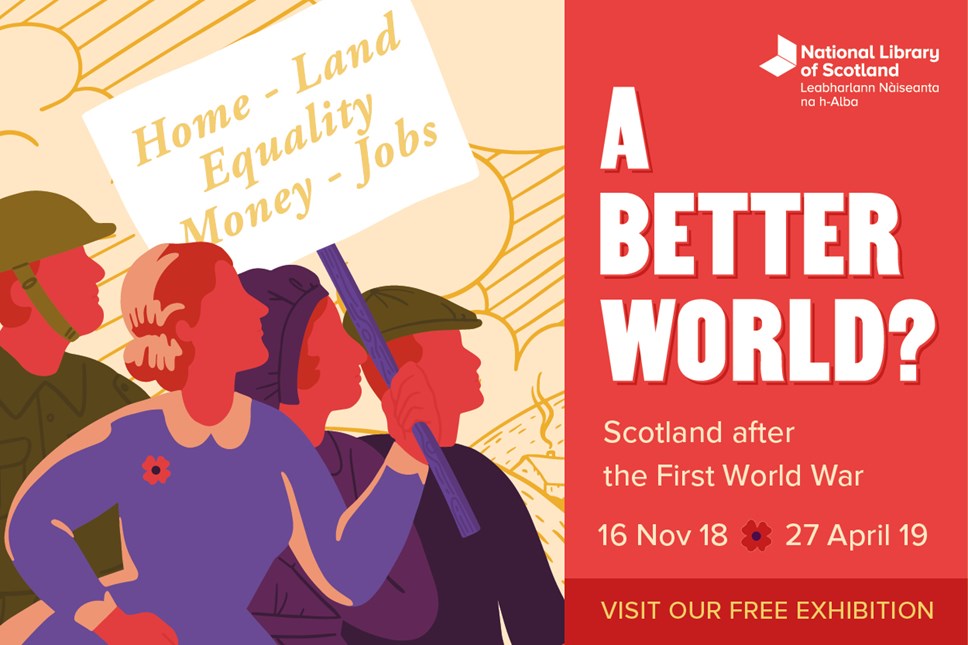
Was it a better world?
A major exhibition exploring life in Scotland after the First World War opens tomorrow, Friday (16 November).
Marking 100 years since the Armistice, the exhibition explores many aspects of Scottish life in the aftermath of the war, including demobilisation, commemoration, the struggle for better working and living conditions, the changing political landscape, and an emerging Scottish cultural and political identity.
Entitled A Better World? Scotland after the First World War, the exhibition reveals some of the many rare or unique items held in the Library’s collections, including a hand-drawn plan of the Scottish National War Memorial, and more personal mementoes for men killed during the war. Visitors will also see newsletters, photographs and other original documents relating to what became known as ‘Bloody Friday’ – when a violent confrontation between police and 100,000 strikers in George Square in 1919 led to the deployment of armed forces to Glasgow.
Also on display are colourful election flyers and posters from a tumultuous period in politics when Scotland’s electorate swelled to more than 2 million, and parties were compelled to appeal to women voters for the first time. Scottish identity is explored through the correspondence of Christopher Grieve (Hugh MacDiarmid) with other young creatives – some of whom had seen active service – as they expressed cultural and political ambitions for their country.
Professor Sir Tom Devine will speak at the launch tonight. He said:
“The National Library of Scotland is to be warmly congratulated on this innovative and poignant exhibition in commemoration of the ending of the Great War in November 1918. Many such events will take place to mark the centenary of peace in Europe in that year but 'A Better World?' is an exhibition with a difference.
“It focuses on what happened in Scotland after 1918 and the hopes of the nation for a better future which would stand as the best possible tribute to those who had sacrificed their lives in the terrible conflict. Carefully selected original items from the wonderful collections of the Library then demonstrate the realities of what happened in Scotland during the 1920s and 1930s.”
Exhibition Curator, Alison Metcalfe, said:
“As we mark 100 years since the Armistice that ended the First World War, the exhibition gives visitors a chance to reflect on what life would have been like for those who survived. There are so many stories to be told about the war, and we wanted to put those in context within 1920s Scotland. We are fortunate that the breadth and depth of the Library’s collections allow us to do that so comprehensively.”
The exhibition is named after a phrase used by the Ministry of Reconstruction, which was formed in 1917 to rebuild the nation after the war. The Ministry developed the idea of rebuilding a society that was fairer than it was before the war, stating that “the idea of… a simple return to pre-war conditions, has gradually been supplanted by the larger and worthier idea of a better world”.
Politicians promised a “land fit for heroes” to a war-weary populace with a new-found political voice – a population with raised expectations of better homes, improved working conditions and hope for a brighter future. Visitors may well reflect on the struggles and achievements of that period, and on the topics that still resonate 100 years on.
A Better World? Scotland after the First World War runs at the National Library of Scotland, George IV Bridge, Edinburgh, from Friday 16 November 2018 until Saturday 27 April 2019.
Contact Information
Notes to editors
The National Library of Scotland
The National Library of Scotland is a major European research library and one of the world’s leading centres for the study of Scotland and the Scots – an information treasure trove for Scotland’s knowledge, history and culture.
The Library’s collections are of world-class importance. Key areas include digital material, rare books, manuscripts, maps, music, moving images, official publications, business information, science and technology, and modern and foreign collections.
The Library holds more than 26 million physical items dating back over 1,000 years in addition to a growing library of e-books, e-journals and other digital material. Every week the Library collects around 3,000 new items. Most of these are received free of charge in terms of Legal Deposit legislation.
